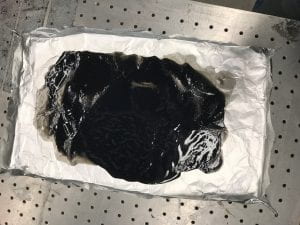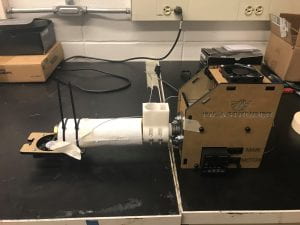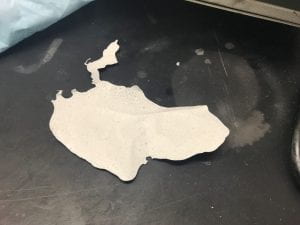Research in Bioengineering
Optimum Design of 3D Printed Polymeric Composites: Biomedical implants
By Zachary Herrera

Portrait of Zachary Herrera
In summer of 2018 I was rewarded with a grant from the Office of Undergraduate Research (OUR) to conduct research within the Bioengineering and Mechanical engineering Labs under Dr. Lamya Karim and Dr. Vijaya Chalivendra. I collaborated with Mechanical Engineering student David O Okide to conduct a research project pertaining to the development of 3D printed polymeric composites, studying the process and properties of our biomaterial of interest. This was an interdisciplinary project allowing me to gain new technical skills from the bioengineering and mechanical engineering fields. Since I entered this field of study my dream has been to produce a device or product that will someday improve the lives of patients who suffer, and this has driven my interest in investigating new innovative materials such as thermoplastics to replace bone. Through this OUR-funded project I was able to apply my interests through in-lab experiments and research.
As recent studies show, diseases such as arthritis and diabetes have become more and more common raising the number of skeletal fractures that occur and operations required to heal damaged bone, thus indicating a need for bone replacements. In this study, I looked into ways to combine different thermoplastics and nanoparticles to increase biocompatibility and mechanical properties of the material. By combining plastics and nanoparticles together the overall strength of the material can be improved and continue to be biocompatible compared to using each polymer individually. Looking towards 3D printing allows us to produce custom-made products and replacements using our desired composite. In order to use 3D printing the desired material must first be created into a filament with specific parameters in order to construct a product for further testing.
Starting with thermoplastic ABS and Carbon nanotubes (CNT) that were readily available, our first step was to determine a process of mixing each material. I chose to use a multi-stepped process using Solvent Casting to dissolve ABS and sonication along with shear mixing to combine 1% CNT within the solution. I used a sonicator and shear mixer to complete this task while adding acetone as my solvent. This was done for 2hrs maintaining a constant temperature of about 55℉. Once materials were done mixing, the mixture was poured onto a sheet of aluminum foil and allowed to dry overnight, shaping our composite into a film (Figure 1)

Figure 1: ABS+1%CNT film used to create filament
The second aim of this project was to create a viable filament with a constant diameter of 2.85mm. In order to carry out this step we assembled our first extruding machine in lab, which was purchased from a 3D printing company called Filastruder (displayed in Figure 2). Once our film was dry, we cut each filament into small squares in order to feed them into the extruding chamber, we then drilled a 2.7mm hole into the nozzle of the extruding machine before extruding to test the change in diameter.

Figure 2: Extruding machine assembled in lab used to create filament
We then maintained a temperature at about 195℃ and the pieces were slowly fed into the extruder through the hopper to create a filament (Figure 3). As the extruder was running we observed a change in shape and texture of the filament from a grainy squeezed shape to completely solid usable filament, by the end becoming bubbly and warped as the material was depleted.

Figure 3: ABS+CNT filament
By examining the texture we found that the filament was not solid enough to be used for further experiments. This simply may be due to the amount of our starting material and by scaling up, could grant us with enough solid filament to use the 3D printer. From the results gathered on the diameter we did not have a constant size suitable for the 3D printer, averaging a measured 3mm. This may be due to the large nozzle size, allowing the filament to expand giving us a larger measurement. One way proposed to fix this issue is to use a type of winder to apply constant tension force onto the filament as it feeds through the tip of the nozzle. Although we did not move onto the 3D printing stage, great progress was made:
- First filament extruding machine (Filastruder) has been assembled and properly used to create a filament.
- CNTs within a polymeric composite were successfully mixed and dispersed, acquiring a working method.
Furthering my work in the bioengineering department, I was able to repeat my method using a tougher polymer called Polylactic acid (PLA). Specifically, I used PLA as my thermoplastic and Titanium Dioxide (TiO2) as the nanoparticle but because PLA is tougher to dissolve chloroform was used as my solvent. This process was moved to a fume hood to contain the toxic fumes also aiding in the drying phase of the solvent casting step. After obtaining a small sample of PLA/TiO2 composite (Figure 4) I was able to test the effectiveness of the process using superior materials.

Figure 4: PLA+1% TiO2 composite
Since this process and ground work laid out shows promising results, further work is needed to integrate our filaments into the 3D printer for testable prints. Therefore, the next step of this project is to confirm the correct amount of PLA combined with chloroform and TiO2 and create a usable filament meeting the required diameter. Next step would be to print dog-bone shaped tensile bars for further mechanical testing and circular disks to test cellular activity and biocompatibility to ultimately be placed within the body. My long-term goal for this project is to determine a usable mixture of thermoplastics and nanoparticles to reach similar mechanical and biological properties as cortical bone to fabricate load-bearing implants.
My research allowed me to explore my interests and different aspects of engineering that I otherwise would not have been able to. I learned about the amount of work that goes into planning, organizing and actually conducting my own research. I am thankful for this opportunity to work with such intelligent professors and peers developing these types of skills in my undergraduate career. I would like to thank the Office of Undergraduate Research for making my research a reality with this opportunity. I would also like to thank Dr. Lamya Karim, Dr. Vijaya Chalivendra, Dr. Jun Li and David Okide for all the help and guidance carrying out this project.
Zachery Herrera.


Great job! It is great to see how your draft turned out so well!